Join the Dots
Words by Caroline Graham – Illustration by James Daw
This story first appeared in issue #16 of Like the Wind
Early Saturday morning. Very early. I’ve carted a supply of cheese-and-pickle sandwiches from France, through Italy, on into Switzerland and am finally taking the remains back towards France. I snatched a few fitful hours of broken sleep on the floor of Courmayeur sports centre and have been wearing the same clothes for 36 hours.
Saturday night. I’m stood in a tent in a random corner of Switzerland waiting to catch a bus which is about to dice with death on a perilously twisty mountain road. My eyes are glued to a small dot on a smartphone screen. My runner.
For most of the past year, the lives of everyone on the bus have been dominated by four letters: UTMB. We’re not just passengers; we’re the friends who have tagged along on the long training runs, the parents who have ferried offspring to races and cooked countless meals (UTMB training is a hungry business) and the spouses who either had to accept and adjust to “the training plan” or who have decided “if you can’t beat them, join them” and are already working out how many points they’ve got and which race they could try for next year.
The Ultra-Trail du Mont Blanc is known the world over as an epic mountain journey: 166km through three countries (including nearly 10,000m of vertical ascent) within 46-and-a-half hours. Entry to the UTMB and its sister races isn’t a simple matter of paying your money and signing on the dotted line. If you can run long distances featuring lots of hills in the right qualifying races, you may earn enough points for UTMB entry. Well… entry into the ballot, anyway. The UTMB family of races are vastly oversubscribed events and, given the nature of the terrain, there’s clearly a limit to how many can compete. Very few are lucky enough to actually secure an entry – so when they do, when they get the chance to be the dot, they want to make it count. For most, this involves enlisting a bit of help. Training takes over life – training to run an awfully long way, training to go up hills, training to go down hills, training to be on your feet for extended periods of time, training to eat and drink on long runs and training to deal with the inevitable catastrophes when things don’t quite go to plan.
My fellow bus passengers are an assortment of languages and ages. Dutiful parents approaching their senior years, still keen to support their children’s sporting efforts – but who hadn’t quite realised that this was going to involve a bit more than making some sandwiches for cricket or washing the hockey kit. Friends supporting their running buddies, knowing that next time they might be the one being supported. Devoted spouses like me supporting the one they love to achieve their dream.
All of us are slightly anxious, having just sent our respective dots out into the dark for the second night in a row, into the mountains, guided by small fluorescent markers and the course marshals stationed at remote junctions. We’re all made even more anxious by the other small group awaiting the bus. The group we try not to acknowledge. The group we don’t quite know what to say to. The group of dots who won’t be setting off into the dark for that second night – whether owing to fatigue, injury, coldness, wetness or simply the loss of the desire to go on any longer. The DNFs.
Everyone on the bus began their journey on Friday evening, undoubtedly most with a tear in their eye, as the rousing anthem sent the 2,300 dots out from the start in Chamonix, pouring under the iconic arch, through the town and off on their trip around the base of Mont Blanc.
For the dots, the task is clear: run, jog, trot, power-hike, walk, shuffle or plod your way round the 103-mile route. Eat and drink lots to keep you going, manage your body appropriately (don’t get too hot, don’t get too cold, don’t get wet, try not to fall over), pass through the checkpoints and keep going until you get back to the start.
To the supporters (or “crew”, as we sometimes like to be considered) it’s a wholly different challenge. Over the past 36 hours I’ve got to know this collection of familiar faces, all playing the same role, united in the support of our dots. Some are like crack F1 pit crews. They arrive at the designated point in their camper van – a key aspiration for all ultra-runners and their crews. Once granted entry to the “Zone d’Assistance” by the checkpoint monitor they spring into action. Access is only granted when your dot is within minutes of arrival and is controlled by a harassed marshal who will scan your crew ticket and reward you with either a nod allowing entry, or a time for you to return, should you be slightly overenthusiastic. The F1 crews have a neatly organised system: dry kit, food and assorted accessories which their dot might (but probably won’t) fancy when they arrive. They too will have trained hard for this event while crewing for their dots at qualifying events – each time adding something else to the list of “stuff that might be useful”.
Others, those who agreed to help out without having the first clue what they signed up for, are slightly bemused as to why anyone would ever want to do this. They look slightly confused when their dot hands them their empty soft flasks and slightly disgusted by the soggy items of clothing slung towards them as their dot merrily strips off in a tent full of other soggy dots. Nevertheless, they are there for their dot.
Throughout Friday night, all day Saturday and into the next night we’ve watched our dots’ progress, making their way steadily from point to point. First St Gervais, then a brief wave and a hello at Les Contamines. Our first crew job proper on Saturday morning in Courmayeur, and then a day following the dot as it climbs through Refuges Bertone and Bonatti before reaching the Grand Col Ferret and now dropping back down, heading towards Champex Lac – Saturday night’s rendezvous. A brief interlude of company before we send our dots off into the night and we venture forth on our next leg.
By this point (more than 24 hours into the race for the majority of average dots), the sleep deprivation is starting to bite. As crew, we have to start thinking for our dots. Have they eaten? Do they need sleep? What needs changing? What needs refilling? This is where it gets tough. Do we indulge their suffering with hugs and sympathy or adopt the approach of endless positivity? Only you know your dot and what they’re going to need when at their lowest. This is perhaps the most important thing you need to learn in your crew training: what your dot requires when the going gets tough.
The elite race was done and dusted hours ago – a brief glimpse of the god and goddess dots of ultra-running at the early checkpoints was all we got. For us, the race extends way beyond night two and is an entirely different affair to the one that concluded the previous evening in the crowds and flashbulbs of Saturday-night Chamonix.
The sun rises. A new day, bright with certainty. Sunday morning greets us and the bus deposits us at a new vantage point. A new tent to sit in. A new spot from which to watch the dot. The anxiety never leaves you. How’s my dot going Is it slowing? Is it OK? We’ve seen our dots head off into the night, greet the dawn over Italy and then watched as night descended in Switzerland to be followed by a new day, in France. And it’s not just me watching my dot; friends, family and running buddies back at home are dotwatching from afar, sending good wishes and all rooting for the dot.
The relief when your dot arrives. A smiley dot, tired but still happy. Doubts receding as the new day banishes the sleep monsters. A flurry of activity: fresh clothing, dry socks, change of shoes, food, refill and restock. We send them off, fortified by breakfast, dry socks, a hug and an extra special treat: the Red Bull and fresh orange cocktail. Off the dots go and the dotwatching begins again.
On our journey goes, back to where it all began. Having come this far, the dot will achieve what he feared he couldn’t. Years of preparation, months of training and hours of contemplating. Watching the dot for those last few hours, as it makes its steady progress back to Chamonix, is agonising. Messages of support for the dot only serve to heighten your anxiety as the dot covers those final kilometres. Through the final checkpoint at La Flégère, the dot moves steadily… and then magically flies down the final descent. The fell-runner within comes to the fore. The tiny screen shows the dot approaching the town. Vantage point carefully selected near a gap in the barriers, a prime spot at which to catch sight of him as he rounds the corner. The steady shuffle picks up into a tired but happy jog and an immense grin. Hand in hand, the dot and I cover the final few metres and under the arch we cross the line. The journey is complete for the dot and I, but already the dot is plotting: what next?

